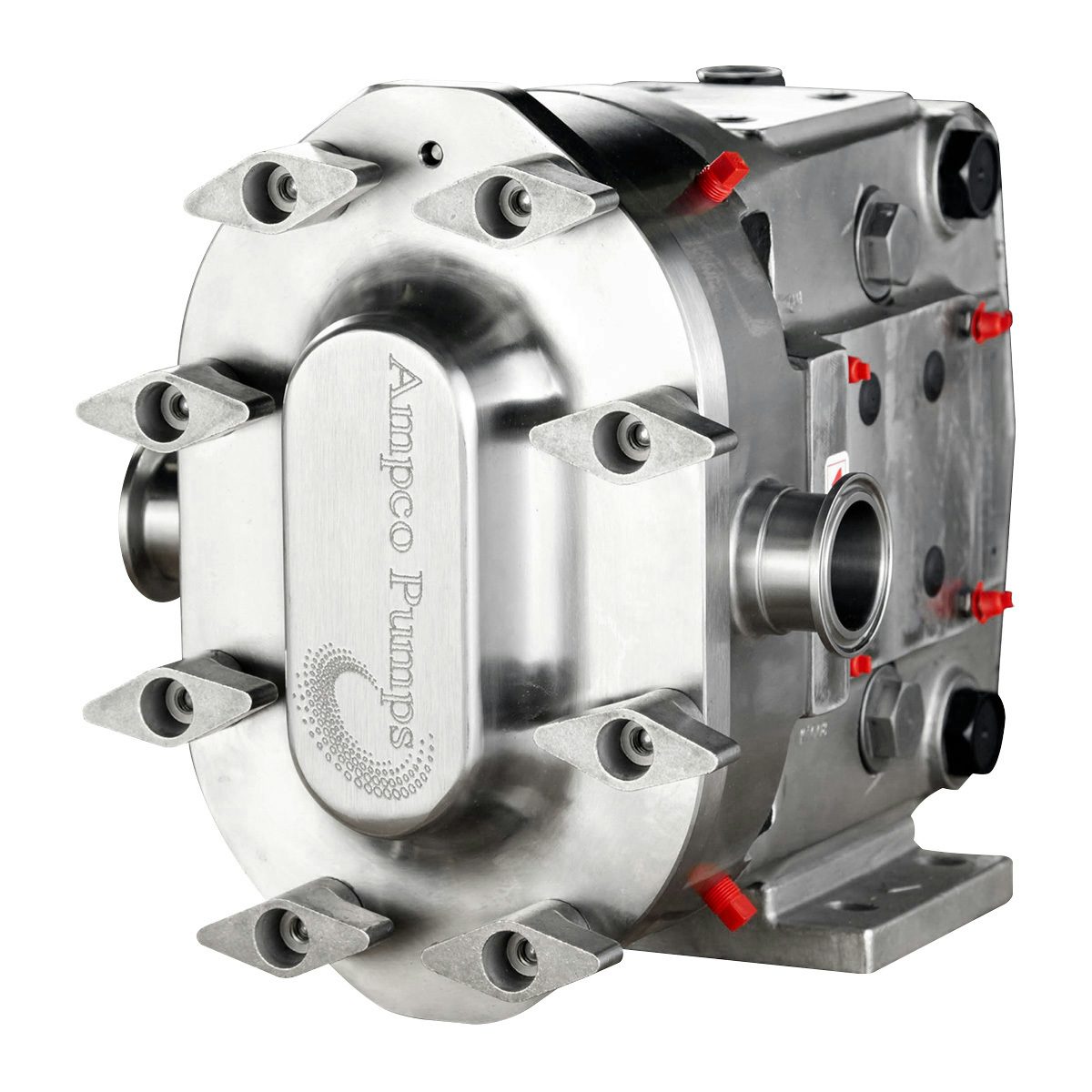Centrifugal Pump vs Positive Displacement Pump in Sanitary Applications

Centrifugal and positive displacement pumps are standard in sanitary applications, including food processing, dairy, biotech, and beverage processing plants. Centrifugal pumps use a spinning impeller that transfers kinetic energy into the fluid being pumped, generating pressure and creating flow. In contrast, positive displacement pumps trap a fixed amount of liquid and force it into the discharge pipe, resulting in a consistent flow of pressure. However, the centrifugal pump's ability to generate discharge pressure decreases as its flow rate increases, unlike the positive displacement pump, which can maintain a consistent pressure.
This article discusses the differences between positive displacement and centrifugal pumps.
Introduction to Pump Types
Pumps are essential in all industries, some of which include food processing, chemical processing, and wastewater treatment. They are crucial in transferring fluids, gases, and slurries from one location to another, ensuring efficient and reliable operations. Among the myriads of pump types available, two main categories stand out: centrifugal pumps and positive displacement pumps. Each type boasts unique characteristics, advantages, and applications, making them indispensable in their respective domains.
Centrifugal pumps and positive displacement pumps are the backbone of many sanitary processes. Understanding their differences and specific uses can help select the right pump for a given application, ensuring optimal performance and longevity.
Sanitary Pump Applications
Sanitary pumps are used in a wide range of industries and applications. From a wet dog food skid at a pet food processor to the latest immunization at a pharmaceutical company to a seasonal brew at your favorite brewery and beyond, sanitary pumps help make processes happen efficiently. These often-unseen pieces of equipment are an integral part of many consumable products enjoyed daily.
Centrifugal Pump Applications
- Water- Ampco AC/AC+ Series, LKH Series Centrifugal Pump, Alfa Laval Solid C Series, Stainless Products SP Series
- Wastewater- Alfa Laval Solid C Series, Ampco AC/AC+ Series, Ampco IC/IC+ Series
- Food- LKH Series Centrifugal Pump, Alfa Laval Solid C Series, Ampco AC/AC+ Series,
- Dairy- LKH Series Centrifugal Pump, Stainless Products SP Series, Ampco AC/AC+ Series, Alfa Laval Solid C Series
- Beverage- LKH Series Centrifugal Pump, Ampco AC/AC+ Series, Alfa Laval Solid C Series
- Pharmaceutical- Alfa Laval LKH UltraPure Series
- CIP Supply and Return-
- Various Applications- LKH Series Centrifugal Pump, Solid C Series, Ampco AC/AC+ Series, Ampco IC/IC+ Series

Positive Displacement Pump Applications

- Food- Alfa Laval DuraCirc Series, Ampco ZP Series, Alfa Laval SRU Series, Wangen NG Twin Screw Series, Wilden HS Series AODD, Wilden FDA Series AODD
- Dairy- Alfa Laval DuraCirc Series, Ampco ZP Series, Alfa Laval SRU Series, Wangen NG Twin Screw Series, Wilden HS Series AODD, Wilden FDA Series AODD
- Beverage- Alfa Laval DuraCirc Series, Ampco ZP Series, A Alfa Laval SRU Series, Wangen NG Twin Screw Series, Wilden HS Series AODD, Wilden FDA Series AODD
- Pharmaceutical- Alfa Laval SX Series, Wangen NG Twin Screw Series
Which Pump Is Suitable for Which Type of Product
The product's viscosity and solids concentration are two essential factors in determining which type of pump to use: centrifugal pumps or positive displacement pumps. A fluid's viscosity is its shear resistance, commonly called its thickness. When factoring in a fluid's viscosity, it is also essential to consider the temperature used when processing. For example, chocolate syrup thickens when cold and is thinner when heated. A centrifugal pump is preferred for lower-viscosity (thinner) products, whereas a positive displacement pump would be preferential for high viscosity liquids and other products.
Centrifugal pumps can handle some undissolved particles in a processing solution, but a positive displacement pump is a better fit for products with a high solids concentration.

Centrifugal Pumps
Key Characteristics of Centrifugal Pumps
Centrifugal pumps are the most common type of pump used across various sanitary processing industries. They operate using a spinning impeller, generating centrifugal force from the pump. This mechanism makes them highly efficient for water and water-like applications. Key characteristics of centrifugal pumps include:
High Flow Rates
Centrifugal pumps are designed to handle large volumes of fluid, making them ideal for applications requiring high flow rates.
Low-Pressure Requirements
These pumps are best suited for low to moderate-pressure requirements.
Versatile Applications
Centrifugal pumps are versatile and can be used in numerous settings.
Easy Maintenance
Centrifugal pumps' simple design makes them easy to maintain, reducing downtime and maintenance costs.
Thin Liquids
Centrifugal pumps move low-viscosity fluids, ensuring smooth and efficient operation.
Self-Priming
Some of these pumps can prime themselves, given the right circumstances, making them reliable in various conditions.
Positive Displacement Pumps
Positive displacement pumps include rotary, circumferential piston, diaphragm, twin screw pumps, peristaltic pumps, and eccentric disc pumps. The advantages and disadvantages of positive displacement pumps vary depending on the specific type of pump, but include the points listed below.
Key Characteristics of Positive Displacement Pumps
Positive displacement pumps, in contrast, are known for their ability to trap a fixed volume of fluid and force it out of the pump. This characteristic makes them particularly effective for specific challenging applications. Key attributes of positive displacement pumps include:
High-Pressure Capabilities
These pumps can generate high pressures, making them suitable for applications requiring significant force.
Low Flow Rates
Positive displacement pumps are designed for applications where precise, low to moderate flow rates are needed.
Viscous Fluids
They can handle thick, viscous fluids that centrifugal pumps might struggle with.
Self-Priming
Some of these pumps can prime themselves, given the right circumstances, making them reliable in various conditions.
Low Shear
These pumps gently handle fluids, making them ideal for shear-sensitive materials.
A Guide to Choosing the Right Pump for Hygienic Applications
This guide is intended for engineers, production managers, or anyone concerned with proper pump selection for pharmaceutical, biotechnology, and other ultra-clean applications.
Centrifugal Pump vs PD Pump: Advantages
Advantages of Centrifugal Pumps
- Ideal for low-viscosity fluids.
- Hygienic design and traceability options available
- Flow rate adjustable with outlet valve
- Low purchase cost
- Simple to maintain
- Small dimensional footprint
- Steady, pulsation-free output
- Single and multistage designs
- Varied flow and pressure outputs
- Compatible with fluids containing small solids
Advantages of Positive Displacement Pumps
- Ideal for high-viscosity fluids
- Provides accurate and consistent output
- Handles shear-sensitive fluids
- Good for fluids containing soft or fragile solids
- Hygienic design
- Traceability options for high-purity applications
- Head pressure doesn’t affect flow output
- Bi-directional flow
- Varying drive speed for output
- Good suction lift capacity
Centrifugal vs Positive Displacement Pump: Disadvantages
Disadvantages of Centrifugal Pumps
- Not good for:
- highly viscous liquids
- fluids with large, suspended solids
- shear-sensitive fluids
- Changes in head pressure impact flow rate
- Impeller’s dynamic action tends to impart air into the product
Disadvantages of PD Pumps
- Low-viscosity fluids can “slip,” reducing efficiency
- Large footprint Requires pressure relief or safety bypass valves
- Moderate flow and pressure pulsation
- Casing contact can cause particulate shedding
- Higher costs
- More maintenance requirements
Pump Performance Comparison
When comparing the performance of centrifugal pumps and positive displacement pumps, it’s clear that each has its own set of strengths and weaknesses. Understanding these differences is key to selecting the right pump for your needs.
- Centrifugal Pumps: These pumps are more efficient at high flow rates and low pressures. Centrifugal pumps are particularly effective at pumping thin liquids, ensuring smooth and efficient operation.
- Positive Displacement Pumps: These pumps excel at high pressures and low flow rates. Their relatively linear performance curve makes them suitable for applications with a consistent flow rate. Positive displacement pumps are more efficient at handling highly viscous fluids, providing a constant flow rate regardless of viscosity changes.
Sanitary Considerations for Pump Selection
Selecting the right pump for a food processing plant or other sanitary application involves several critical factors. These considerations ensure that the pump performs efficiently and maintains the highest standards of hygiene and safety.
- Material of Construction: The pump should be made from corrosion-resistant materials and easy to clean. Stainless steel is a common choice due to its durability and hygienic properties.
- Surface Finish: A smooth surface finish is essential to prevent bacterial growth and ensure easy cleaning.
- Seal Design: The pump should have a robust seal design to prevent leakage and contamination and maintain the integrity of the processed product.
- Cleaning and Sanitizing: The pump should be easy to disassemble, clean, and sanitize, ensuring it meets stringent sanitary standards.
By carefully considering these factors, you can select the right pump for your sanitary application, ensuring efficient, reliable, and hygienic operation.

Choosing Between Centrifugal Pumps and Positive Displacement Pumps
Choosing between centrifugal and positive displacement pumps in sanitary applications depends on the process’s specific needs, including fluid viscosity, solids concentration, and the required flow rate. Overall, centrifugal pumps are ideal for low-viscosity liquids in high-purity applications, and they offer a simple and cost-effective solution. However, it is important to note that the centrifugal pump's flow rate decreases as the differential pressure increases.
Conversely, positive displacement pumps offer excellent handling of high-viscosity fluids and shear-sensitive materials. Positive displacement pumps create a flow by trapping and transferring fixed volumes of liquid, which results in pressure, making them essential for process applications that require precision and consistency.
Both types have advantages and disadvantages, so carefully selecting the right pump for a specific processing application ensures reliable and efficient performance in the food, beverage, biotech, and pharmaceutical industries.
Centrifugal vs Positive Displacement Pump FAQs
- How do I choose between a centrifugal pump and a positive displacement pump?
- Choosing between a centrifugal pump and a positive displacement pump depends on the fluid's viscosity, the presence of solids, and the required flow rate. Centrifugal pumps are ideal for low-viscosity fluids, while positive displacement pumps are better for thicker, high-viscosity liquids or fluids with solids.
- What are positive displacement pump types?
- There are several types of positive displacement pumps. These include rotary lobe, circumferential piston, air operated double diaphragm pumps, twin screw pumps, peristaltic pumps, peristaltic and eccentric disc pumps.
- Which type of pump is preferred for pumping thin liquids?
- It depends, but lower-viscosity fluids are typically best processed using a centrifugal pump, especially in high-purity processing.
- Can a centrifugal pump handle fluids with solids?
- Centrifugal pumps can handle fluids containing small, suspended particles, but a positive displacement pump is a better choice for fluids with a high solids concentration. Positive displacement pumps can gently handle shear-sensitive fluids and those containing fragile solids.
- Which pump type is better for high-viscosity fluids like syrups or oils?
- A positive displacement pump is generally preferred for highly viscous fluids such as syrups or oils. These pumps handle thick fluids efficiently and provide a constant flow rate regardless of viscosity changes.
Contributing Author

Michael David is the Manager of Pump and Heat Exchange Solutions at CSI. Michael received his B.S. degree in Mechanical Engineering from the Missouri University of Science and Technology, and brings over 17 years of experience in engineering, process design, fluid dynamics, and maintaining equipment for the food, dairy, beverage, biopharm and biotech markets. Michael supports a team of application specialists who focus on Pump and Heat Exchange solutions. He also leads many training initiatives for internal and external customers aimed at developing competence and confidence in the worlds of pumps and heat exchange technology.
ABOUT CSI
Central States Industrial Equipment (CSI) is a leader in distribution of hygienic pipe, valves, fittings, pumps, heat exchangers, and MRO supplies for hygienic industrial processors, with four distribution facilities across the U.S. CSI also provides detail design and execution for hygienic process systems in the food, dairy, beverage, pharmaceutical, biotechnology, and personal care industries. Specializing in process piping, system start-ups, and cleaning systems, CSI leverages technology, intellectual property, and industry expertise to deliver solutions to processing problems. More information can be found at www.csidesigns.com.
